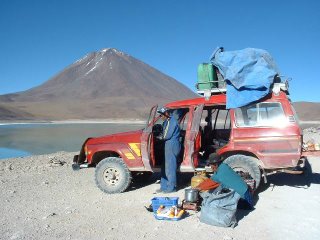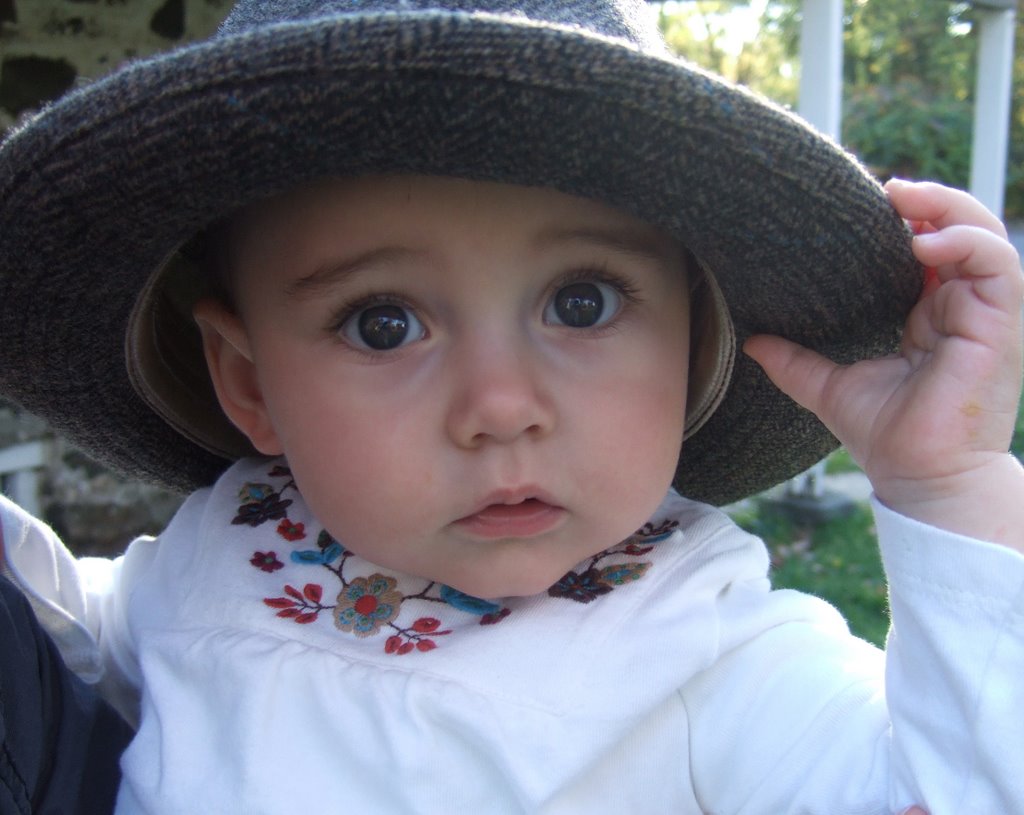The beginning of our Bolivian adventure...

Hailing friends and family,
Wow! The Lonely Planet guidebook says that Bolivia can swallow up film, and they couldn't be more right. Dan and I have returned from the most incredible, scenic 4-day jeep trip through Southern Bolivia. 4 loooonnng days in a big jeep with 8 people, on some of the worst, rocky, dusty dirt roads, sin ducha (without shower)!
To start at the beginning...
Immediately after crossing the Argentine border to Villaron, Dan and I were well aware that we were in a new country, B0LIVIA. It is the manner of dress that makes this initially so apparent. Most traditional Bolivian women (called campesinas if they live in the country, cholas if they live in the city) wear thick woolen tights with sandals, several puffy knee-length skirts, an apron, a button-up sweater over a collared shirt, a shawl that often acts as a baby or grocery carrier, and a bowler hat worn high on the head over two long, waist-length braids of black hair. This 'uniform' was enforced by the Spanish colonizers in the 18th century.
Tupiza, a small agricultural, valley town surrounded by rugged, terracotta hills, is another countryside gem. Here, the vegetation and scenery is similar to the quebradas in Argentina, and the national parks of Utah (Bryce and Zion). The famous gangsters, Butch Cassidy and the Sundance Kid, escaped capture in the U.S., by heading for this part of Bolivia. They continued their criminal ways by robbing local banks, and stealing payroll money meant for Bolivian miners. It was in the tiny village of San Vincente that they finally met their ends, chased by a couple of posses, and driven to suicide (as one story goes). The local hostals capitalize on the Old West sentiment of this story, and arrange horse trips for gringos through the awesome rainbow-colored canyons. Dan and I (cowboy and sore-arsed cowgirl), went on a 5 hour horseride meandering through the Valle de los Machos, otherwise called the Valley of penises (I'm sure that you can picture the natural rock formations), and scrambled through narrow, steep canyons of red rock. Through our hostal, Valle Hermosa, we organized our further overland expedition to the Salar de Uyuni.
The next morning, we met our spanish-speaking guide, Abraham, and his amor (our cook), Justina, a traditional Bolivian chola. We were introduced to our fellow travelers on this 4-day expedition, and to our 'take-a-beatin' red SUV/jeep. Dan and I were the only english speakers, traveling with 4 frenchies. I cannot say that we were initially thrilled with this arrangement. It is no fun being the odd couple out, cramped in a car for a good 10 hours a day, without understanding a word of french. To add to this minor disappointment, we had to combat some of the worst body odor, occasional bad breath, and nostril clogging dust that inevitably seeped into the car. I actually preferred the dust stinging my nostrils to shutting the windows and choking on bodily musk. It would be easy to say it was the fact that we couldn't shower that created the stank, but it wouldn't be true! Dan and I smelled perfectly fine, damn them! Here is where I make a desperate plea to other people - please, please, respect the olfactorys of your fellow travelers and wear some deodorant if you are going to be stuck in a car for 4 days!!! By the last day, my patience had seriously waned, and one couples' lack of hygiene had me in a particularly foul mood.
Enough of the bitching... other than minor inconveniences, the trip was a fantastic adventure through endless, incredibly beautiful terrain. I don't know how our jeep made the journey. The roads were the most dreadful we have yet encountered. Our first two days we hardly encountered another vehicle on our narrow, windy, rocky way, crossing streams, and climbing mountains. Our guide / driver actually has to be a mechanic who is well versed in preventive care for his vehicle. Day 1, and I had little faith that our 4 day journey would not turn into a weeklong saga of being stuck in the middle of nowhere. Over the course of our tour, Abraham had to stop a few times a day to inspect his engine, cool off the front brakes with a liberal dousing of water, refill the tank with gas from a barrel on the car roof, and fix numerous other malfunctions that arose. These included tightening the leaf springs, taking off a car wheel for who knows why?, fixing the passenger door which would not unlock, and replacing a fuse for an electrical window (this was particularly important, because it was the drivers window, the sun was going down, temperatures were dropping, and Abraham was unable to shut his window to protect himself from the bitter cold. He had to shut Justina's shawl in the door to create a temporary barrier.). Every time we took a break to take photos and wander through the splendor of the antiplano, Abraham had to peek under the car hood, or climb beneath the entire jeep for a more thorough inspection. He really had a hard job - a full 12 hours each day, yet his humor never sagged, and Dan and I really grew to like this very smiley, optimistic man. His partner, Justina, turned out to be a fantastic helper, running for any tool or bucket of water that Abraham required. She also made the most delicious vegetarian soups and lunches. We had heard such horror stories about the food on these trips and were very pleasantly surprised. We even got to try llama! It is a very lean, clean meat that tastes very similar to beef, but is a little on the tough side.
All of the amazing scenic stops we made are far too numerous to mention, but these were some of the highlights:
Firstly, the wildlife - herds of llamas prancing around with hot pink tassels tied to their ears, wild, graceful vicuñas in shades of creamy brown darting away from the roadside pastures, condors coasting in mountain thermals, the occasional pair of rheas, a strange rodent that looks like a bunny with a monkey's tail, and fantastically pink flamingos (James, Andean, and Chilean species).
Secondly, the small villages of indigenous people. When we would first arrive into some of these small pueblos of stone and mud homes, the children, men and women would peek curiously at this strange coach of gringos. Abraham was always able to break the ice, and explain that we were genuinely curious about how these people lived and survived in the rugged terrain. Shyness would be overcome with laughter, and I would be able to ask the women a few tentative questions, like 'how many children do you have?' I'd usually get a response of 5 to 7! At the heights we were at (anywhere between 3500-5000 meters), agriculture is nearly impossible. These people derive an economy from their herds of llama and sheep. They have no doctors, and rely on a keen knowledge of medicinal herbs for their remedies. One of our fellowtravelerss, a french man in his 60's was suffering from soroche (altitude sickness), and Abraham and Justina picked local herbs to make him a mate (tea). We were all eager to sample the different plants that they picked and shared with us, including the drinking and chewing of coca leaves to alleviate any headaches related to the high altitude.
Lastly, the scenery...breathtaking. Every day, we passed through a new type of topography. Everything from strange rock formations bursting through the earth (Arbol de Piedra), to volcano peaks (like Licancabur- 5960 meters), to thermal pools, geysers, and bubbling mudpots, to technicolor lagoons. The lagoons were my particular favorite, because they were usually full of colonies of flamingos, and the colors of the water were simply unreal - pale blues, emerald greens and orangey, pinkish burgundies. The pictures we have of Laguna Colorada, its rich acid red color and flights of flamingos, barely touch on the beauty of this area.
Our final day was spent on a sea of salt - the never ending, blinding white of the Salar de Uyuni, which stretches for 12106-sq-km. The best stop during this day was at the Isla de los Pescadores (actually Isla Inca Huasi), a small, hilly, island covered in Trichoreus cactus in the midst of the salt plains. We ended our tour in Uyuni, with a quick visit of the cemetery of trains, a rusting junkyard of old steam locomotives, surrounded by a desert of trash. Literally, there are plastic bags and other abandoned debri as far as the eye can see. Bolivia has a huge sad problem with trash disposal. It is a harsh reminder of the evil we can do to our world.
-------
It is day 3 since our 4-day tour, and Dan and I are now in Potosi, the highest city in the world at 4090 meters. We are taking a break from road travel, and soaking up the immense culture that this city has to offer. The story of our Cerro Rico mining adventure will continue in our next email and photos will be posted as soon as possible. http://www.pbase.com/dgsc/boliv1
missing you all, but not ready to return,
Sarah and Daniel
(---After my Uyuni tour without bathrooms, I quickly realized how useful skirts are for a semi-private squat!).(in case you were interested...)



0 Comments:
Post a Comment
<< Home